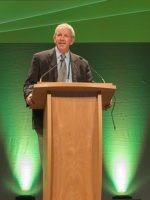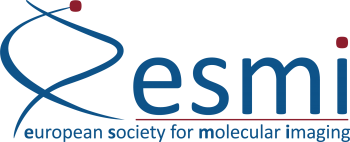IMAGING the HALLMARKS of CANCER
“Neither the sun nor death can be looked at with a steady eye”
Francois de La Rochefoucauld (1613-1680).
Today’s in vivo images of cancer demonstrate that cancer is no longer synonym of death but still linger somewhere in between blindness and clarity. The next stage in cancer imaging will be to produce and interpret in vivo images of cancer according to the biological hallmarks of cancer defined by Hanahan and Weinberg: sustained proliferative signaling, evasion from growth suppressors and immune destruction, enabling of replicative immortality, tumor-promoting inflammation, activation of invasion and metastasis, induction of angiogenesis, genomic instability and mutation, resistance to cell death and deregulation of cellular energetics.
THANKS to all of you who contributed a great conference!
“Congratulations for a great conference! This conference was excellent not only for the science but also for the friendly athmosphere, the professionel organization, the inspiring discussions […]”
TOPIM 2013 participant
The 10 biological hallmarks of cancer defined by Hanahan and Weinberg defined also the topics for TOPIM 2013. Per topic some speakers were invited to give a talk within their field of expertise and additional talks were choosen from the submitted abstracts.
The programme started on Monday morning with a 3h introductory Keynote lecture by Robert Gillies. Further Keynote lectures were given by Douglas Hanahan and John Condeelis.
Keynote Lectures
Douglas Hanahan

Douglas Hanahan is Director of the Swiss Institute for Experimental Cancer Research – ISREC in Lausanne. In 2000, Douglas Hanahan and Robert Weinberg published a very influential paper called “The Hallmarks of Cancer” in the journal Cell in which they suggested 6 hallmark traits that confer malignancy on cells. This classic paper was recently updated (Hanahan and Weinberg 2011) to add two additional “emerging” hallmarks and two “enabling characteristics.”
John Condeelis

John Condeelis is Professor & Co-Chair of Anatomy & Structural Biology at the Albert Einstein College of Medicine in New York. His research interests are in optical physics, cell biology and biophysics, cancer biology and mouse models of cancer. He and his collaborators developed the multiphoton imaging technology and animal models used to identify invasion and intravasation microenvironments in mammary tumors. This led to the discovery of the paracrine interaction between tumor cells and macrophages in vivo, and the role of macrophages in the migration of tumor cells and their dissemination from primary tumors via blood vessels to distant metastatic sites read more
Robert Gillies

Robert J. Gillies is vice-chair of Radiology, director of the Department of Imaging Research and co-leader of the Experimental Therapeutics Programme at the Moffitt Cancer Center in Tampa, USA. His research is focused on functional and molecular imaging of cancer: tumour microenvironment, imaging biomarkers for therapy, tumour targeting ligands. He is a member of the Cell and Molecular Imaging Probes – CMIP study section at NIH and a member of IRG-A Cancer Center Grants parent committee at NCI.
Poster Session and Award
Two guided poster sessions were held this year in Les Houches. The best poster presenters had the opportunity to give a talk the following day. The winners:
Sylvia Le Dévédec from Leiden
Christoph Griessinger from Tuebingen

TOPIM 2013 was also co-funded by the FP7 project INMiND – Imaging of Neuroinflammation in Neurodegenerative Diseases.
TOPIM 2013
Date: January 20-25, 2013
Place: École des Physique des Houches, France
“This was the best meeting I have ever attended. I learned more in one week than I have learned in one year. Thank you for this amazing week. I will never forget TOPIM 2013.”
TOPIM 2013 participant
TOPIM 2013 documents
Invited speakers per topic/hallmark
- Kevin Brindle – Cambridge, UK on “resisting cell death”
- Eyal Mishani – Jerusalem, Israel on “sustaining proliferative signaling”
- Jacco van Rheenen – Hubrecht Institute Utrecht, The Netherlands on “enabling replicative immortality”
- Dik van Gent – Rotterdam, The Netherlands on “genome instability”
- Fabian Kiessling – Aachen, Germany
- Klaas Nicolay – Eindhoven, The Netherlands on “inducing angiogenesis, and activating”
- John Griffiths – Cambridge, UK on “reprogramming of energy metabolism”
- Varda Rotter – Rehovot, Israel on “evading growth suppressors”
- Paolo Comoglio – Institute for Cancer Research in Candiolo, Italy on “invasion and metastasis”
- Caius Radu – UCLA Dept. of Molecular & Medical Pharmacology on “reprogramming of energy metabolism” and “genome instability”
- Philippe Bousson – Institute Pasteur Paris Dynamics of Immune Response Lab and
- Wijnand Helfrich – University Medical Center Groningen , Translational Surgical Oncology and
- Federico Roncaroli – Imperial College, London on “evading immune destruction”
TOPIM 2013 Programme Committee
- Bertrand Tavitian – Paris, France CHAIR
- Marion De Jong – Rotterdam, The Netherlands
- Silvana Del Vecchio – Naples, Italy
- Uwe Haberkorn – Heidelberg, Germany
- Andreas H. Jacobs – Muenster, Germany
- Tony Lahoutte – Brussels, Belgium
- Michal Neeman – Rehovot, Israel
- Vasilis Ntziachristos – Munich, Germany
- Gooitzen van Dam – Groningen, The Netherlands
“The scientific level of the talks – also of some young researchers was great, I enjoyed the conference a lot and it has been an honour to be able to participate. The programme set-up has been fantastic […].”
TOPIM 2013 participant
